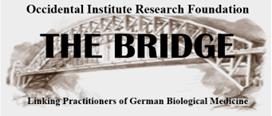The regulation of pH values inside and outside the cells is an essential prerequisite for the function of the enzymatic controlled metabolism processes of our organism. However, the relationship from acid to base is not only of importance for a healthy metabolism, but also determines the structure and function of proteins, the permeability of cell membranes, the distribution of electrolytes as well as the function of the connective tissue.
On the basis of current scientific knowledge levels, long-term disturbances of the natural acid-base balance are increasingly observed as a risk factor for the pathogenesis of chronic illnesses like, for example, osteoporosis. With an experimentally brought about acidosis, a reduction of the buffer capacity of the blood occurs first, with a further increasing acid burden to a reduction of the intracellular buffer capacity and a burdening of the buffer capacity of the bones, and finally with a continuing acid burden to a buffering through release of mineral materials from the bone.
Already in the 1960’s, these realizations led to the hypothesis that osteoporosis is caused in considerable degree through a high acid load in the food. In the meantime, there are numerous epidemiological studies about the possible connections between nutritional forms and the origin of osteoporosis. The positive influence of a vegetarian nutrition on the bone density is possibly based also on a favorable acid-base content of the food; a higher base content correlates with a higher bone density. Comparative studies with non-vegetarian and vegetarian women showed that a high proportion of effective basic foods led to a clearly improved calcium balance in vegetarians.
Despite equal calcium supply in both groups, in the group of non-vegetarian women with higher acid secretion, calcium excretion was increased significantly. Also with pre-menopausal women, a connection between the supply of basic foods and the bone density was described. The supply of potassium and magnesium and a high consumption of fruits and vegetables correlates with a higher bone density, not however the calcium content of the consumed foods.
Altogether the epidemiological data clearly point out a connection between the quantity of basic substances from fruit and vegetables supplied over the years and with osteoporosis in addition to observable effects on the calcium and bone metabolism. Intervention studies largely confirm the physiological effects of the latent acidosis. If an artificial acid burden is caused only by an increase of the protein supply, then at first an increased removal of calcium by the kidney is observed. However, through the simultaneous supply of bases the protein-induced acid burden of the organism can be prevented and an elevated calcium loss is avoided. As well, through targeted base supply of the ketoacidosis condition one can prevent calcium loss through fasting.
Also modern diets contribute to the loss of bone substance. With observance of a strictly carbohydrate-reduced diet ([e.g.] the Atkins diet), there occurs a considerable burden on the acid-base household with clear acidosis, negative calcium balance and elevated secretion from the bone degradation parameters.
The protective function that an elevated consumption of vegetables has contrary to animal protein can be confirmed in overlapping international studies. Hip fractures occur with distinguishable frequency in the population of different countries and stand in direct context according to the society’s distinguishable higher consumption of animal protein. The evaluation of the data of hip fracture occurrence in 33 countries compared with the respective country-by-country characteristics of the per capita consumption of animal and vegetable foods shows that hip fracture incidence is lowest in countries with low consumption of animal protein. Further studies show that older women with a high protein consumption of animal origin present a faster bone density loss and a higher hip fracture risk than women with high consumption of vegetable protein. This can be explained in that they can neutralize the acid derived from the protein metabolism in addition to the protein from contained organic anions in plants.
The positive effect of an elevated base supply can also be proven with intervention studies:
With women after menopause base supplementation affected both a diminution of the bone degradation as well as an increase of the bone regeneration.
The maintenance of a sound physiological pH milieu is at the cost of the bone mineral content since a latent acidosis causes the release of minerals from the bones through which the surplus protons are buffered out. At first, a metabolic acidosis stimulates the physicochemical release of mineral materials (decrease of the sodium, potassium, carbonate and phosphate content of the bones), and afterwards the cell-mediated bone reabsorption. Throughout an acidosis the activity of the bone degradation cells (osteoclasts) is increased and the activity of the bone constructive cells (osteoblasts) is inhibited.
Genes that regulate the early “immediate reaction” of the osteoblasts are hindered in the same way as the genes that control the bone matrix formation, through which the new formation and reconstruction of bone tissue is altogether throttled.
In-vitro studies on isolated bone cells show the dependence of the net calcium flux on the pH value of the surrounding mediums. With a pH value below 7.4 calcium pours out from the bone cells into the medium, whereas a net absorption of calcium is verifiable only with a pH value above 7.4.
Admittedly a latent nutritional acidosis condition will not evoke any massive alterations of the Blood pH on the basis of the compensation mechanisms. Nevertheless the compensation leads inevitably to the consumption of the body’s own buffer reserves and thereby predominantly to the loss of bone substance if the acid burden remains in the long-term nutrition existing through an excess at animal protein and a lack of base equivalent. The undisputed positive influence of a fruit and vegetable rich diet has therefore been explained not only by way of a high supply of micro-nutrients and secondary plant content materials but also by way of the positive effect of a high base supply.
With an altogether too low portion of fruits, vegetables and salad a supplementation with bases is a meaningful measure for the preservation of bone substance.

An exclusive translated article for Affiliates
From THE BRIDGE Newsletter of OIRF
Published January 31, 2005
From an article in Naturheilpraxis, Issue #57, May 2004
Machine Translation by SYSTRAN and Lernout & Hauspie
Translation and redaction by: Carolyn L. Winsor, OIRF
© Copyright 2004, Dr. Vormann & Institute for Prevention & Nutrition, Ismaning/Munich, Germany



